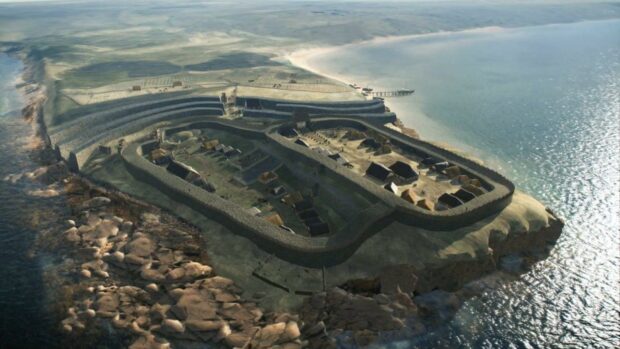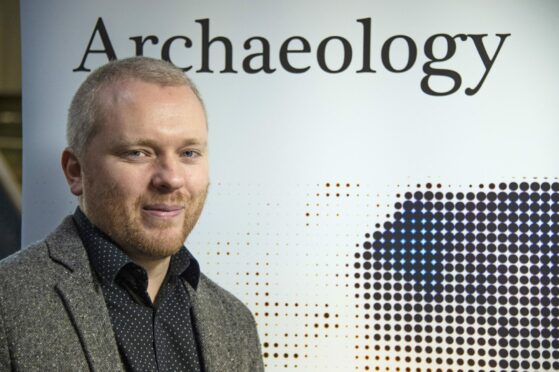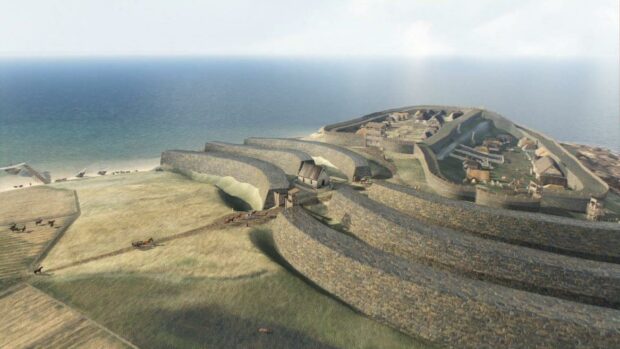Stunning new reconstructions have revealed how Scotland’s largest Pictish fort would have looked 1,000 years ago.
Three-dimensional images of Burghead in Moray were created based on archaeological excavations by the University of Aberdeen.
The images show the enormous defensive ramparts, thought to be eight metres thick and six metres high, as well as dwellings within the fort.
It has long been known that Burghead was home to a Pictish settlement. However, experts believed the 19th century development of the modern town had eroded most traces of this important period of its history.
The landward ramparts were levelled and part of the seaward defences was destroyed in order to build the modern harbour.
This destruction of the fort uncovered more than 30 Pictish carved stones. But just six carved bulls have survived, along with a number of fragments of early Christian sculpture.
Archaeologists expected little: how wrong they were
When University of Aberdeen archaeologists first began excavations in 2015, they expected little to have survived such extensive building work close by.
Over the last five years, however, a very different picture has emerged.
The digs, led by the university’s Professor Gordon Noble, and funded by both Historic Environment Scotland and the Leverhulme Trust, have yielded some of the most significant Pictish items and building remains ever uncovered.
It is this work which has enabled such a detailed reconstruction of how the site may have looked. Professor Noble and his team have received national recognition for their work in helping us understand our Pictish ancestors.
“The scale of houses and buildings we have discovered evidence of show that this was a densely populated and important Pictish site,” said Professor Noble.
“We have found many objects which have helped us to learn more about the everyday lives of Burghead’s inhabitants between the 6th and 10th centuries AD.
“From metalworking to weaponry and even hair and dress pins, with each new dig we are finding out more about our ancestors who lived here.
“The foundations of the huge ramparts have survived far better than anyone anticipated, despite their wilful destruction over the centuries.
“And the midden layers, effectively where Picts threw their rubbish, have provided startling insights into the lives of Picts.
“These stunning reconstructions offer an amazing insight into how Burghead may have looked.”
‘Built to be dramatic and imposing’
The reconstructions are the result of extensive filming – including with an aerial drone – and 3D imaging.
They also include a spectacular well enveloped in the ramparts. Elements of this can still be seen today and the archaeologists have pieced together how this fitted with dwellings and other buildings across the site.
Previous excavations uncovered evidence of early Christian occupation, supporting theories that a chapel once stood at the entrance to the site. This has been translated into the 3D design.
The fort at Burghead was destroyed by fire in the 10th century – a time when Vikings are known to have been raiding the Moray coastline.
This brought to a rapid end a way of life which had endured for centuries. The fort then remained unoccupied until around the 12th century.
Dr Kevin Grant, archaeology manager at Historic Environment Scotland said: “Burghead fort was one of the most important places in early medieval Scotland, and was built to be dramatic and imposing.
“These reconstructions help us imagine experiencing this spectacular site in its hey-day.
“The excavations are transforming our understanding of Pictish Scotland and saving important archaeological remains from being lost to the waves.”
Excavations are continuing, in order to further understand how those who lived at the site connected to the wider world.
More from the Schools and Family team
First Class 2021: This year’s P1 intake in the north and north-east


